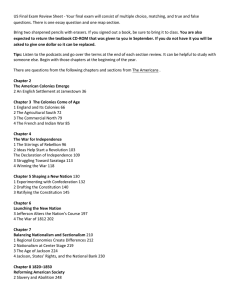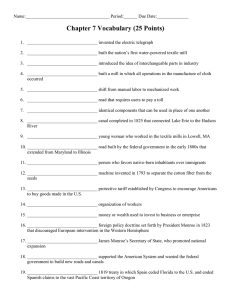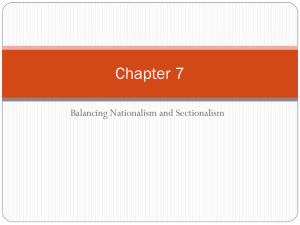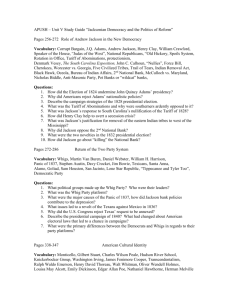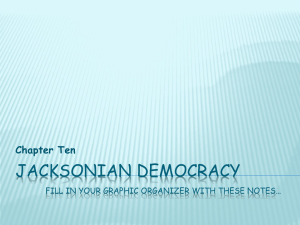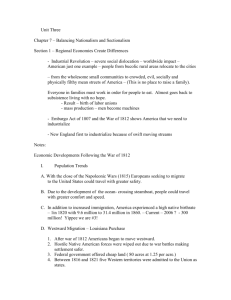Chapter 7
advertisement
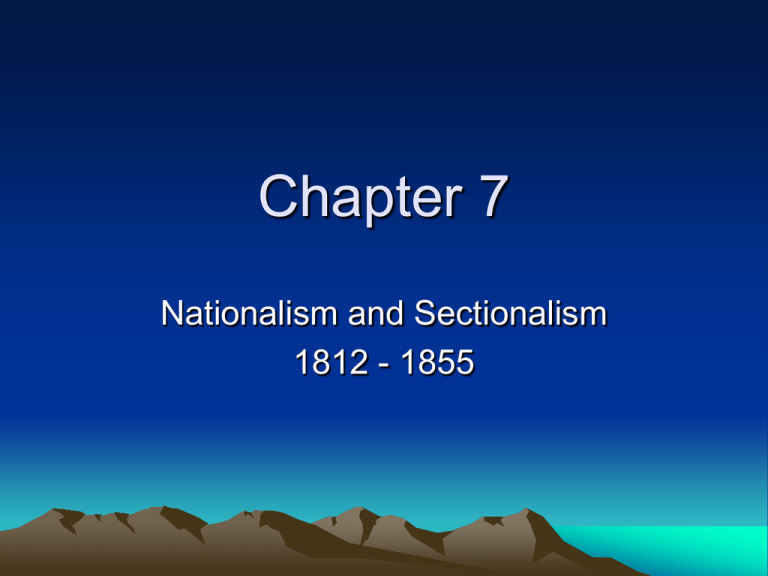
Chapter 7 Nationalism and Sectionalism 1812 - 1855 1. Industry and Transportation • What were some of the key developments in transportation of the early 1800’s? • Explain/analyze the rise of industry in the U.S. in the early 1800’s. • Describe some of the leading inventions and industrial developments in the early 1800’s. • New developments in technology, transportation, manufacturing will set the country on a path of industrialization for decades Transportation • Early travel: carts, wagons, stagecoaches • Turnpikes built – toll paid but few profited • Steamboat – Robert Fulton – first steam powered boat in U.S. (coal or wood) • Named Clermont • Could now travel upstream • Revolutionized river and ocean travel Transportation cont. • Growth of canals – mostly in northeast • Erie Canal – across New York (Hudson River to Lake Erie) • http://www.history.com/shows/americathe-story-of-us/videos/building-the-eriecanal • Produce could now be sent to NY quickly which led to NY becoming a major commercial center Railroads • Most dramatic improvement – developed in GB – appeared in U.S. 1820’s • First pulled by horses; later used steam • Could carry much heavier freight • Cost less to build than canals and could travel faster George Stephenson’s “ROCKET” Industrial Growth • Developments in technology transformed manufacturing • Known as the Industrial Revolution • Transformed culture, social life and politics • Began in Britain late 1700’s • Used steam or flowing rivers to power machines • Textile industry first Samuel Slater • Emigrant from England who knew how steam machinery worked – Was illegal for British citizens to leave the country if they knew the secrets to the machinery – Secretly left England to start business in America • Pawtucket, Rhode Island – Set up first successful textile mill in the U.S. – Techniques copied and by 1814, there were about 240 textile mills in America – Family system – all lived together in town owned by factory owner Lowell Mills • Francis Cabot Lowell established first mill at Waltham, MA • Created/controlled all aspects of production not just thread • Employed young, single women – “Lowell Girls” • Strict rules of behavior; had to live in Lowell housing Slater’s Mill & Spinning Frame Lowell Mill and Lowell Women Industry cont. • Changed workers’ lives as well • Divided work into small, specific tasks • Little skill required so little training required • Less costly to employ unskilled workers • Downside for workers? New Inventions • Interchangeable Parts (Eli Whitney) • Products traditionally made by skilled craftsmen and were unique • Parts are now made identically and interchangeably • Significance? Inventions cont. • Sewing machine • Elias Howe – improved by Isaac Singer • Lowered cost of making cloth into clothing Communication • Samuel F. B. Morse • Telegraph • Electrical pulses over wires; dots and dashes • Morse Code • Revolutionized communication Farming • New developments • John Deere – steel plow • Cyrus McCormick - reaper 2. Sectional Differences • Why did industry take root in the North? • Describe the impact of industrialization on northern life. • Analyze the reasons that agriculture and slavery became entrenched in the South. Sectional Differences • Embargo of 1807 & War of 1812 had reduced access to British manufactured goods • Post war – flood of imports, threatened American manufacturers • Tariff of 1816 – increases prices • Helped industrial Northeast but hurt farmers • Why Northeast? Waterways for power; more capital to invest; more workers; southern land and climate favored agriculture Social Change • Industry required fewer skills; paid lower wages; skilled artisans lost significance and wages • Factories – long hours, low pay, tedious tasks, child labor, horrible conditions, urban society – tenements, no sanitation, little fire, police presence; dangerous • See Venn Diagram (North & South) Social Change • Workers organized labor unions; united to seek better pay, conditions • Used strikes sometimes • Middle class emerges – bankers, lawyers, accountants, clerks, brokers, retailers • Moved away from urban areas; poor couldn’t afford to move so became segregated by class, heritage, etc. Immigration • Mid 1800’s workers increasingly made up of immigrants • Irish potato famine • German political problems; uprisings • Mainly Catholic, Jewish • New England cities; factories, docks, domestic servants Immigration cont. • Clustered in urban areas by nationality/background • Competed for jobs • Discrimination, hostility, attacks • Nativists campaigned for laws to restrict immigration Southern Agriculture • Slavery had died out or been outlawed in North • In the South the cotton gin spurs expansion of agriculture, slavery • Removed seeds from cotton • Invented by Eli Whitney • By 1860 – 4 million slaves (1.5 mil. 1820) • Price - $1,800 ($600 in 1820) Cotton Gin • “King Cotton” became major export in South • Filled growing demand from northern textile factories • Cotton/textiles accounted for half of all U.S. exports Economic Consequences • Dependent on one crop – sometimes prices were low so some went bankrupt • Didn’t encourage industry and entrepreneurship • Only one major city – New Orleans • Population grew slowly (didn’t attract immigrants) – this increased political power of the North Economic Consequences cont. • • • • One in four owned slaves; usually 3-4 Very few owned 100 slaves or more Why did it continue then? Farmers hoped to have plantations one day and feared freeing slaves • Felt racially superior, slavery helped the southern economy • Claimed it was kinder than industrial life 3. Era of Nationalism • Analyze the causes and effects of nationalism on domestic policy during the years following the War of 1812 • Describe the impact of nationalism on the nation’s foreign policy • Summarize the struggle over the issue of slavery as the nation grew Nationalism • Surge in pride and national identity following War of 1812 • “Era of Good Feeling” • Democratic Republicans essentially only party • James Monroe – 5th president • Henry Clay and other D-R’s supported tariffs; American System – wanted federal government to build roads, canals, to link Atlantic with Midwest – “internal improvements” Nationalism cont. • Also favored Bank of U.S. • 2nd bank established (1816) • Irony: This is the group who hated federal power! • Marshall Court – Expands Court’s power • Marbury v. Madison (JR), McCulloch v. Maryland (Bank), Gibbons v. Ogden (Int. Commerce) – Federal law over state law – govt. can regulate interstate commerce, can create Bank • Shift from single businesses or proprietorships to corporations Economic Panics • Periodic shocks or downturns in the economy • Boom or Bust cycles common in capitalism (driven by supply and demand) • Boom – high demand, high prices, high production • Bust – goods exceed demand, falling demand, falling prices • 3 panics 1819, 1837, 1857 Nationalism in Foreign Affairs • Adams-Onis Treaty – Gave Florida to the U.S. – Ended Spanish claims to Oregon Territory • Opened up new areas for expansion • Monroe Doctrine – warned European powers to stay out of western affairs • Reflected our desire for power Compromise over Slavery • Spirit of nationalism failed to suppress growing sectional (regional) differences • 1820 – Missouri Compromise is reached (Henry Clay) • Maine admitted as a free state, Missouri as a slave state; kept balance equal • No slavery permitted North of 36 degrees • Only temporarily solved the issue of slavery (can you compromise on this?) Jefferson Quote • “This momentous question, like a fire-bell in the night awakened and filled me with terror. I considered it at once the death knell of the Union.” 4. Age of Jackson • 1824 – John Quincy Adams; Jackson loses; “corrupt bargain” (goes to House, Clay gives support to JQA then gets a Cabinet post) • Election of 1828 campaigned across the country (a new idea) • National politics growing more democratic (electors chosen by people, property restrictions dropped so more could vote) – see chart page 251; still no women/blacks Jackson cont. • • • • He became the symbol of democracy Jacksonian Democracy Celebrated majority rule, common people Born in a log cabin, orphaned, fought in American Revolution; but actually became a wealthy attorney in Tennessee; war hero against Indians & New Orleans • By 1828 – supporters called Democrats Jackson • A return to strong state govt., weak federal power that would not interfere with basic rights (including slavery) • A return to Jeffersonian Democracy • Rewarded service with govt. jobs – the “spoils system” – criticized for this Native American Removal • Jackson - Strong political base in the South • 60,000 Native Americans lived here • Cherokee, Creek, Chocktaw, Seminole, Chickasaw – land seized • Supreme Court rules (Worcester v. GA) that GA can’t interfere with Indians • Jackson ignored it! (Favored states here) • Executive branch – enforces laws Native Americans cont. • Indian Removal Act 1830 • Southern tribes would be moved to western territory (Oklahoma) • Trail of Tears – route traveled by thousands of Indians; starved, frozen, beaten, shot – over 4,000 died 5. Constitutional Crisis & Disputes • Tariffs were a long debated issue • North favored (protected business) South opposed (higher prices) • 1828 – Tariff of Abominations • John Calhoun (SC) violently opposed tariff (remember he was a War Hawk – strong nationalist – switched to states’ rights) • Future of slavery depended on states’ rights Crisis • 1832 – SC nullifies (void) tariff and threatened to secede (break away) if the govt. tried to enforce • Jackson, a strong state supporter drew the line here – the Union must be preserved (favors federal law over state law) • Threatens to send troops (Force Bill) • Daniel Webster defends national unity • Tariff reduced; crisis avoided (for now) The Bank War • Jackson opposed Bank – saw this as elitist, favoring North, industrialists, left out the southern farmers, laborers • 2nd Bank charter renewed • Jackson vetoed it (rarely used) – Bank unauthorized by Constitution • Opponents denounced him as a power hungry tyrant (“King Andrew”) – new party Whigs Whigs • Many of old Federalists – wanted strong national govt., broad (loose) interpretation of the constitution, protective tariffs, internal improvements, national bank • Renewed two-party politics • 1832 – Jackson reelected After Jackson • 1836 – Martin Van Buren new Democratic president • Panic of 1837 – revived Whig party • 1840 - Whig William Henry Harrison – “Tippecanoe (Indian defeat) and Tyler too” wins; effective campaign • First Whig victory
